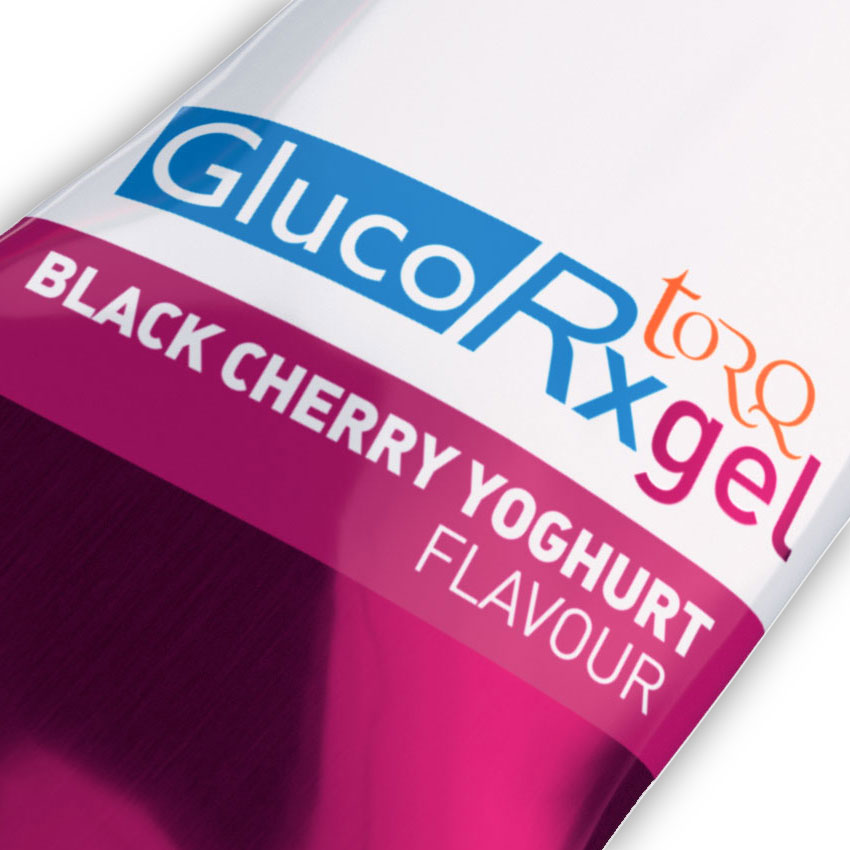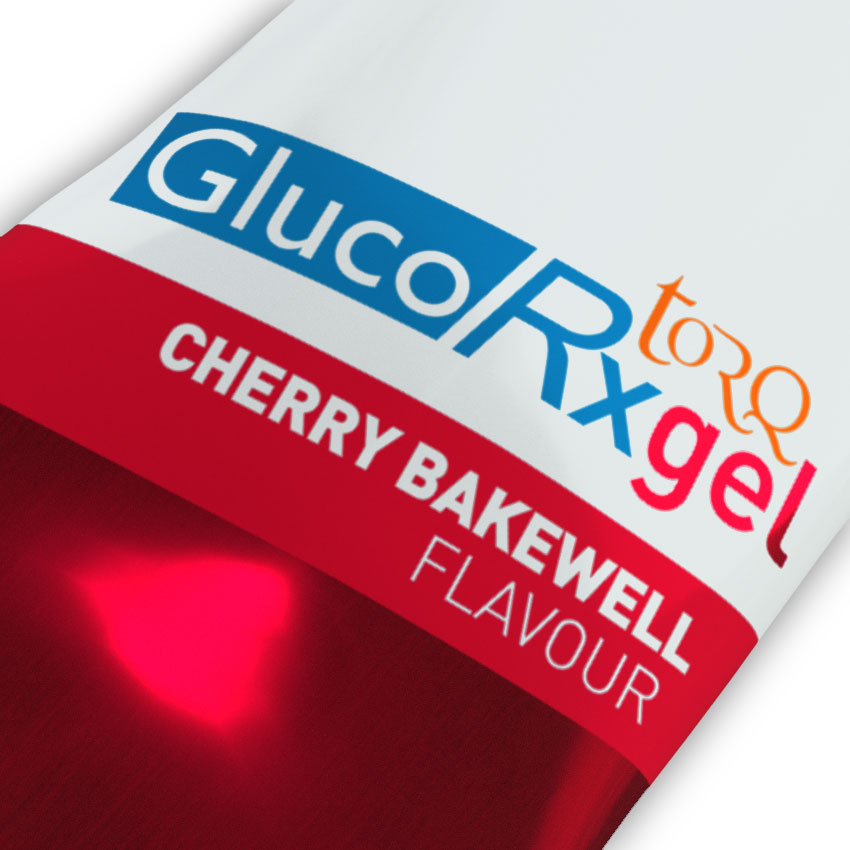TORQ GlucoRx Gel is a product that has been developed specifically for people with diabetes.
Product Summary
Ingestion of a 15 gram dose of carbohydrate followed by a blood glucose test 15 minutes later is a mnemonic used by the American Diabetes Association and many others. It is considered the “rule of 15” – consuming 15 grams of carbohydrate followed by a 15-minute wait and repeated again if blood glucose remains low.
TORQ have successfully applied the latest Sports Science research (see research tab) into a great tasting carbohydrate gel containing precisely 15-grams of fast-acting carbohydrate. The Sports Science research upon which we rely has been fundamental to the development and formulation of our cutting-edge TORQ Fuelling System products, used by athletes and physically active people for many years.
We have applied this cutting-edge research to diabetes, since the rapid delivery of carbohydrate required by endurance athletes to maximise performance is similarly desirable in raising blood glucose when people with diabetes experience hypoglycaemia (low blood glucose). The speed of carbohydrate delivery is critical to both of these populations.
The 15 gram dose of carbohydrate is delivered via a smooth, great tasting gel formulation, packaged in a conveniently transportable tube with an easy-tear top.
TORQ have partnered with GlucoRx who have a vast amount of experience in the world of diabetes and are the UK’s leading supplier of blood glucose testing and monitoring equipment.
NHS Prescription
The TORQ GlucoRx Gels are available in boxes of 3 x 15g gels, in 3 flavours, Black Cherry Yoghurt, Raspberry Ripple and Cherry Bakewell and can either be purchased directly from GlucoRx via the product links above or are available on prescription from the NHS.
If you would like to have these gels prescribed, please quote the following PIP Codes to your GP or Nurse:
Black Cherry Yoghurt: PIP Code 408-9728
Raspberry Ripple: PIP Code 408-9710
Cherry Bakewell: PIP Code 415-6634
If you would like to purchase directly from GlucoRx, click HERE.
Unlike our regular performance TORQ Energy Gel, the TORQ GlucoRx Gel isn’t primarily intended for use during exercise, but for the specific purpose of delivering carbohydrate in the fastest possible manner to manage the recovery from hypoglycaemia. That said, there is clear logic surrounding the regular consumption of a smaller 15 gram dose of fast-acting carbohydrate during exercise rather than the hefty 30 gram dose the standard TORQ Energy Gel supplies if you would like to have finer control over your blood glucose whilst exercising. To this end, there is no reason why the TORQ GlucoRx Gel couldn’t be used during exercise.
Technical Information
The use of a 2:1 Maltodextrin:Fructose formulation in this product is based on exactly the same research that we have used in the development of our regular performance TORQ Energy Gels, which are designed to deliver carbohydrate extremely quickly albeit in an entirely different set of circumstances.
The reason 2:1 Maltodextrin:Fructose works faster than glucose-only preparations is most easily explained by following the two animations below. Maltodextrin is a low-osmolality glucose-derivative (many glucose molecules bonded together in a chain) and although glucose-derivatives do deliver glucose more quickly into the blood than fructose (fruit sugar), the SGLT1 transporter in the lining of the intestine (responsible for glucose absorption) quickly becomes saturated, causing the glucose molecules to queue up for absorption. Play the very short animation below, which shows how the maximum absorption rate of glucose is limited to 60 grams per hour (1 gram per minute):

On the other hand, if fructose is combined with glucose at a 2:1 ratio, notice how utilisation of the GLUT5 transporter trickles fructose into the bloodstream independently of glucose, allowing a total absorption of 90 grams of carbohydrate per hour (1.5 grams per minute). Take a look at the second animation to understand this process:

For comprehensive information and education on diabetes, please refer to the range of tabs at the bottom of the page at this link.
Product Usage
For people with diabetes, the approach recognised by the American Diabetes Association and many others, to rapidly raise blood glucose levels in order to manage the recovery from hypoglycaemia, is to consume 15g of fast acting carbohydrates, wait 15 minutes, re-test your blood glucose and then repeat if needed. To deliver TORQ GlucoRx Gel’s 15g dose of fast-acting carbohydrates, tear off top of gel packaging and consume all the contents of the tube. Take a blood glucose measurement 15 minutes later and repeat with an additional dose if necessary.
Why Gel?
What does this product give me that a few jelly babies or a bottle of sugary drink doesn’t? The answer is clear when you look at the detail. The TORQ GlucoRx Gel gives you:
1. A faster access to carbohydrate (we can’t think of a quicker way to get 15g of carbohydrate into your body, especially if you’re in a position whereby you need assistance to administrate it).
2. A precise 15 gram dose of fast-acting carbohydrate from an advanced formulation based on a significant and growing body of peer-reviewed published research (there are over 2o studies listed on the research tab).
3. A clean and simple delivery system in a strong compact pack that’s easy to store and transport without the risk of damage or contamination.
4. Amazing flavours and a smooth texture, making the product extremely palatable.
Nutritional Information
Nutritional Information for all flavours of TORQ GlucoRx Gel are supplied under this tab.
Black Cherry Yoghurt Flavour
Ingredients: Maltodextrin (Glucose Polymers 43%), Water, Fructose (21%), Citric Acid, Electrolytes (Sodium Chloride, Potassium Chloride, Calcium Lactate, Magnesium Carbonate), Natural Flavour (0.2%), Preservative (Potassium Sorbate).
| per 23.5g serving | per 100g | |
|---|---|---|
| Energy (kJ) | 250 | 1065 |
| Energy (Kcal) | 60 | 255 |
| Fat (g) | 0 | 0 |
| of which saturates (g) | 0 | 0 |
| Carbohydrates (g) | 15 | 63.9 |
| of which sugars (g) | 5 | 21.3 |
| Fibre (g) | 0 | 0 |
| Protein (g) | 0 | 0 |
| Sodium (mg) | 26 | 111 |
| Chloride (mg) | 45 | 190 |
| Potassium (mg) | 6 | 26 |
| Calcium (mg) | 2.4 | 10 |
| Magnesium (mg) | 0.5 | 2.3 |
Allergy Information: No allergens. No gluten containing ingredients used.
No Preservatives // No Colours // No Artificial Sweeteners // Natural Flavouring // Wheat-Free // Dairy-Free // Suitable for Vegans
NHS PIP Code: 408-9728
Raspberry Ripple Flavour
Ingredients: Maltodextrin (Glucose Polymers 43%), Water, Fructose (21%), Citric Acid, Electrolytes (Sodium Chloride, Potassium Chloride, Calcium Lactate, Magnesium Carbonate), Natural Flavour (0.2%), Preservative (Potassium Sorbate).
| per 23.5g serving | per 100g | |
|---|---|---|
| Energy (kJ) | 250 | 1065 |
| Energy (Kcal) | 60 | 255 |
| Fat (g) | 0 | 0 |
| of which saturates (g) | 0 | 0 |
| Carbohydrates (g) | 15 | 63.9 |
| of which sugars (g) | 5 | 21.3 |
| Fibre (g) | 0 | 0 |
| Protein (g) | 0 | 0 |
| Sodium (mg) | 26 | 111 |
| Chloride (mg) | 45 | 190 |
| Potassium (mg) | 6 | 26 |
| Calcium (mg) | 2.4 | 10 |
| Magnesium (mg) | 0.5 | 2.3 |
Allergy Information: No allergens. No gluten containing ingredients used.
No Preservatives // No Colours // No Artificial Sweeteners // Natural Flavouring // Wheat-Free // Dairy-Free // Suitable for Vegans
NHS PIP Code: 408-9710
Cherry Bakewell Flavour
Ingredients: Maltodextrin (Glucose Polymers 43%), Water, Fructose (21%), Citric Acid, Electrolytes (Sodium Chloride, Potassium Chloride, Calcium Lactate, Magnesium Carbonate), Natural Flavour (0.2%), Preservative (Potassium Sorbate).
| per 23.5g serving | per 100g | |
|---|---|---|
| Energy (kJ) | 250 | 1065 |
| Energy (Kcal) | 60 | 255 |
| Fat (g) | 0 | 0 |
| of which saturates (g) | 0 | 0 |
| Carbohydrates (g) | 15 | 63.9 |
| of which sugars (g) | 5 | 21.3 |
| Fibre (g) | 0 | 0 |
| Protein (g) | 0 | 0 |
| Sodium (mg) | 26 | 111 |
| Chloride (mg) | 45 | 190 |
| Potassium (mg) | 6 | 26 |
| Calcium (mg) | 2.4 | 10 |
| Magnesium (mg) | 0.5 | 2.3 |
Allergy Information: No allergens. No gluten containing ingredients used.
No Preservatives // No Colours // No Artificial Sweeteners // Natural Flavouring // Wheat-Free // Dairy-Free // Suitable for Vegans
NHS PIP Code: 415-6634
If you would like to discuss your diabetes, or would like any further information, please don’t hesitate in contacting us on enquiries@torqfitness.co.uk or by telephone on 0344 332 0852.
References
The following extensive references support the use of multiple-transportable carbohydrates and forms the basis upon which all of TORQ’s fuelling products are formulated. The technology we use to enhance the performance of athletes Worldwide is now being used to help people with diabetes:
- Stellingwerff, T & Cox, GR. (2014)
Systematic review: Carbohydrate supplementation on exercise performance or capacity of varying durations. Appl Physiol Nutr Metab. 2014 Sep;39(9):998-1011. - Wilson. PB., Ingraham, SJ. (2015)
Glucose-fructose likely improves gastrointestinal comfort and endurance running performance relative to glucose-only. Scand J Med Sci Sports. [Epub ahead of print]. - Currell, K & Jeukendrup, A.E. (2008)
Superior endurance performance with ingestion of multiple transportable carbohydrates. Med Sci Sports Exerc. 40(2):275–81. - Triplett, D., Doyle, D., Rupp, J., Benardot, D. (2010)
An isocaloric glucose-fructose beverage’s effect on simulated 100-km cycling performance compared with a glucose-only beverage. Int J Sport Nutr Exerc Metab. 20(2):122–31 - Tarpey, M.D., Roberts, J.D., Kass, L.S., Tarpey, R.J., Roberts, M.G. (2013)
The ingestion of protein with a maltodextrin and fructose beverage on substrate utilisation and exercise performance. Appl Physiol Nutr Metab. 38(12):1245–53. - Rowlands, D.S., Swift, M., Ros, M., Green, J.G. (2012)
Composite versus single transportable carbohydrate solution enhances race and laboratory cycling performance. Appl Physiol Nutr Metab. 37(3):425–36. - Baur, D.A., Schroer, A.B., Luden, N.D., Womack, C.J., Smyth, S.A., Saunders, M.J. (2014)
Glucose-fructose enhances performance versus isocaloric, but not moderate, glucose. Med Sci Sports Exerc. 46(9):1778–86. - Rowlands, D.S., Thorburn, M.S., Thorp, R.M., Broadbent, S.M., Shi, X. (2008)
Effect of graded fructose co-ingestion with maltodextrin on exogenous 14C-fructose and 13C-glucose oxidation efficiency and high-intensity cycling performance. J Appl Physiol. 104:1709–19. - O’Brien, W.J & Rowlands, D.S. (2011)
Fructose-maltodextrin ratio in a carbohydrate-electrolyte solution differentially affects exogenous carbohydrate oxidation rate, gut comfort, and performance. Am J Physiol Gastrointest Liver Physiol. 300(1):G181–9. - O’Brien, W.J., Stannard, S.R., Clarke, J.A., Rowlands, D.S. (2013)
Fructose–maltodextrin ratio governs exogenous and other CHO oxidation and performance. Med Sci Sports Exerc. 45(9):1814–24. - Rowlands, D.S., Swift, M., Ros, M., Green, J.G. (2012)
Composite versus single transportable carbohydrate solution enhances race and laboratory cycling performance. Applied Physiology, Nutrition, and Metabolism. 37(3): 425-436. - Smith, J.W., Pascoe, D.D., Passe, D., Ruby, B.C., Stewart, L.K., Baker, L.B., et al. (2013)
Curvilinear dose-response relationship of carbohydrate (0–120 g·h−1) and performance. Med Sci Sports Exerc. 45(2):336–41. - Roberts, J.D., Tarpey, M.D., Kass, L.S., Tarpey, R.J., Roberts, M.G. (2014)
Assessing a commercially available sports drink on exogenous carbohydrate oxidation, fluid delivery and sustained exercise performance. J Int Soc Sports Nutr. 11(1):1–14. - Jentjens, R.L., Underwood, K., Achten, J., Currell, K., Mann, C.H., Jeukendrup, A.E. (2006)
Exogenous carbohydrate oxidation rates are elevated after combined ingestion of glucose and fructose during exercise in the heat. J Appl Physiol. 100(3):807–16. - Jeukendrup, A.E & Moseley, L. (2010)
Multiple transportable carbohydrates enhance gastric emptying and fluid delivery. Scand J Med Sci Sports. 20(1):112–21. - Davis, J.M., Burgess, W.A., Slentz, C.A., Bartoli, W.P. (1990)
Fluid availability of sports drinks differing in carbohydrate type and concentration. Am J Clin Nutr. 51(6):1054–7. - Jentjens, R.L., Venables, M.C., Jeukendrup, A.E. (2004)
Oxidation of exogenous glucose, sucrose, and maltose during prolonged cycling exercise. J Appl Physiol. 96(4):1285–91. - Jentjens, R.L., Achten, J., Jeukendrup, A.E. (2004)
High oxidation rates from combined carbohydrates ingested during exercise. Med Sci Sports Exerc. 36(9):1551–8. - Wallis, G.A., Rowlands, D.S., Shaw, C., Jentjens, R.L., Jeukendrup, A.E. (2005)
Oxidation of combined ingestion of maltodextrins and fructose during exercise. Med Sci Sports Exerc. 37(3):426–32. - Jentjens, R.L., Moseley, L., Waring, R.H., Harding, L.K., Jeukendrup, A.E. (2004)
Oxidation of combined ingestion of glucose and fructose during exercise. J Appl Physiol. 96(4):1277–84. - Jentjens, R.L & Jeukendrup, A.E. (2005)
High rates of exogenous carbohydrate oxidation from a mixture of glucose and fructose ingested during prolonged cycling exercise. Brit J Nutr. 93:485–92. - Fuchs, C.J., Gonzalez, J.T., Beelen, M., Cermak, N.M., Smith, F.E., Thelwall, P.E., Taylor, R., Trenell, M.I., Stevenson, E.J., van Loon, L.J. (2016)
Sucrose ingestion after exhaustive exercise accelerates liver, but not muscle glycogen repletion compared with glucose ingestion in trained athletes. J Appl Physi. [Epub ahead of print].
For reviews see…
Jeukendrup, A.E. (2010). Carbohydrate and exercise performance: the role of multiple transportable carbohydrates. Curr Opin Clin Nutr Metab Care. Jul;13(4):452-7.
Rowlands, D.S., Houltham, S., Musa-Veloso, K., Brown, F., Paulionis, L., Bailey, D. (2015). Fructose-Glucose Composite Carbohydrates and Endurance Performance: Critical Review and Future Perspectives. Sports Med. Nov;45(11):1561-76.










